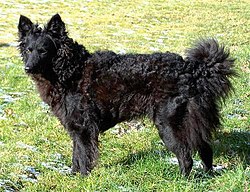| Mudi | |||||||||||||||||||||||||
|---|---|---|---|---|---|---|---|---|---|---|---|---|---|---|---|---|---|---|---|---|---|---|---|---|---|
 A black Mudi | |||||||||||||||||||||||||
| Origin | Hungary | ||||||||||||||||||||||||
| |||||||||||||||||||||||||
| |||||||||||||||||||||||||
| Dog ( domestic dog ) | |||||||||||||||||||||||||
The Mudi is a herding dog breed from Hungary. It is closely related to the Puli and Pumi, from which it was separated in the 1930s. They continue to be used in herding, as well as participating in a variety of dog sports.

